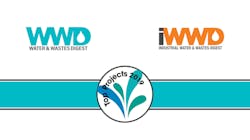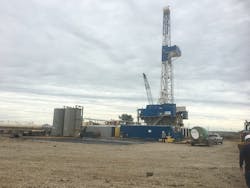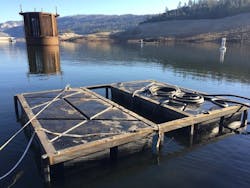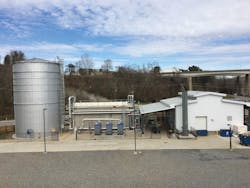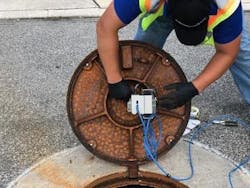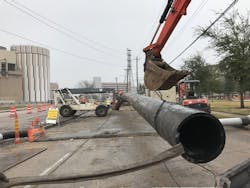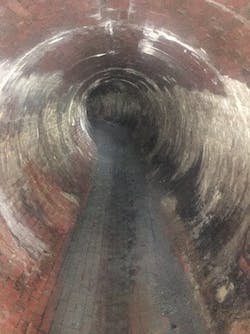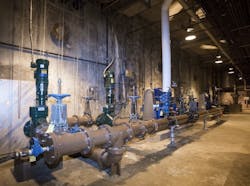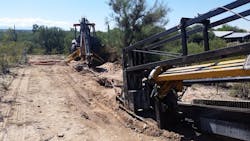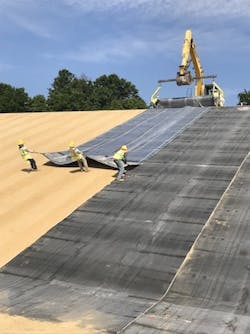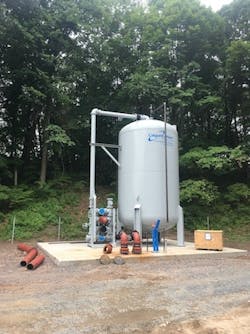WWD & iWWD Announce Top Project Winners for 2019
|
Nominate for next year's awards! |
Water & Wastes Digest and Industrial Water & Wastes Digest awarded their 2019 Top Project winners with crystal awards Monday, Sept. 23 at Maggiano's Little Italy in Chicago during WEFTEC 2019. Each project was nominated through forms on the Water & Wastes Digest website and were evaluated by the editorial team. The winners exemplified excellence in collaboration, strength in overcoming project challenges and taking their project beyond just construction and technical goals. Below are the list of project winners for iWWD and WWD with data points and small blurbs about each project.
Also awarded at the ceremony Monday night was the 2019 WWD Industry Icon award. This award is given to an individual in the industry who has gone above and beyond to elevate an industry issue, making themselves iconic for their work. This year’s winner is Doug Riseden, technical support manager for Krausz Hymax. Riseden wants to make everybody in the industry safer, particularly those working in trenches. He has hosted seminars and has taught trench safety lessons at events across the country and his passion for the issue is seemingly unmatched.
Read more about Riseden’s passion for safety, career history and life goals.
WWD #1 Top Project & Industry Icon Video Interview
| Nominate a WWD Top Project | Nominate an iWWD Top Project | Nominate an Industry Icon |
Industrial Water & Wastes Digest Top Projects
BGE Beaver Generation Plant
Location: Claskanine, Ore.
Project Size: 1,200 gpm
Facility Size: 1,200 gpm
Budget Cost: $120,000
Summary: Northwest Pump Provided the equipment, fabrication and installation for the replacement of three outdated and failing sewage lift stations for the PGE Beaver Generation Plant in Clatskanie, Ore. The facility required these lift stations to be completed in an 8 to 10 hour work day as not to disrupt its options. This work was completed after much planning as the site is remote and required many safety meetings and other requirements.
Magnus Services Smart Water Control
Location: North Dakota
Project Size: Not specified
Facility Size: Not specified
Budget Cost: Not specified
Summary: Magnus Services aimed to be more congnizant of its water supply at all its fracking sites while reducing the necessary personnel required to control water use and to also better track water for delivery truck scheduling. By instituting a cloud-based solution, required personnel for this work was reduced to one, water levels in each truck are monitord and automatically report to the cloud-based system, and all controls can be monitored remotely to minimize workflow disruption.
Cherry Dam Environmental Project
Location: Yosemite Valley, Calif.
Project Size: 310 ft of head, 1150 gpm
Facility Size: 484,737,662 gal of water pumped
Budget Cost: Not specified
Summary: Cherry Dam on the border of Yosemite Valley, Calif., needed to remove and replace two 66-in. hallow-jet valves. For this replacement to be completed safely, the reservoir had to be drained below the intake tower so no water flowed through the dam during removal and replacement. Pumped water needed to be diverted over the damn to keep the site of the butterfly valves clear to perform the repair work. The main challenge was to provide a pumping system capable of maintaining 5 cu ft per second of water up and over the dam (310 ft from low lake level to the top of the dam).The pumps needed to work constantly throughout the months-long duration of the project to keep water running for fish and wildlife.
Castello di Amorosa Winery Wastewater Package Plant
Location: Calistoga, California
Project Size: 6,250 gpd winery process wastewater
Facility Size: 7,500 gpd
Budget Cost: Less than $182,000
Summary: The Castello di Amoroso winery in Calistoga, Calif., is a 107 room castle that sits against Napa County's Mayacamas Mountains and overlooks California’s wine country. The new packaged wastewater treatment system replaced concrete tanks and a leach field, which had failed. Unlike residential wastewater, winery wastewater usually does not contain pathogenic bacteria in the waste stream; however, biochemical oxygen demand (BOD) and total suspended solids (TSS) are found in significantly higher concentrations. In fact, BOD and TSS concentrations can be 40 times as great as household wastewater with 12,000 mg/L BOD and 6,000 mg/L TSS being typical during harvest activities. At other times of the year, the various winemaking activities create fluctuating flows, which create system over-capacity concerns. The need for versatility in design and operation is key in selecting a winery wastewater treatment system.
iWWD #1 Top Project - New Belgium Brewery
Location: Asheville, North Carolina, USA
Project Size: 142,000 gpd
Facility Size: 500,000 barrels of beer annually
Budget Cost: Not made public
Summary: New Belgium Brewing’s core values include producing world-class beers and preserving environmental stewardship. As part of its sustainability efforts, New Belgium Brewing wanted a more responsible approach to managing its water. This included installing an on-site wastewater treatment system that would generate an effluent to Asheville, N.C., discharge requirements. Due to the limited amount of space available on site and that the facility is located near a residential area, the system required a compact footprint and needed to mitigate odors associated with the wastewater treatment. The brewing company chose ananaerobic membrane bioreactor system based on the raw wastewater characteristics (a combination of process wastewater, spent yeast and hops), treatment requirements, limited space availability and the proximity of the wastewater treatment plant to a neighboring residential community. The system consists of a 330,000 gal continuously stirred tank reactor paired with an 86,000-gal membrane tank. The system was designed to treat up to 142,000 gpd of wastewater and generate a final effluent with BOD and TSS concentrations of less than 230 mg/L.
Water & Wastes Digest Top Projects
SAWS Smart City Monitoring
Location: San Antonio, TX
Project Size: 200 smart manhole covers for 70 miles of sewer
Facility Size: 5,589 miles of sewer main; 110,655 manholes; 287 siphons; 413 miles large diameter pipe; 90 miles of force main; 5,176 miles small diameter pipe; 152 lift stations; and 3 wastewater treatment plants
Budget Cost: $300,000
Summary: The San Antonio Water System sought a means to transition from a calendar-based cleaning and maintenance schedule to a condition-based one. By installing smart manhole covers, it generated the data it needed to optimize cleaning of its vast network of sewers and pipe. The real time monitoring is also paired with trend analysis to identify problems with the system days or weeks before they occur.
Texas Medical Center Sewer Rehab
Location: Texas Medical Center in Houston, Texas
Project Size: 4,542 ft of sanitary sewer rehabilitation
Facility Size: 34 mgd
Budget Cost: $4.05 Million
Summary: As a result of the devastating effects of Hurricane Harvey in Houston, the main sanitary sewer system of the Texas Medical Center was seriously impacted. This impact was mainly reflected in two enormous cave-ins produced as a result of the collapse of a rectangular sanitary sewer concrete box of 60 in. wide by 42 in. high by 80 ft in length underneath N. MacGregor Way and of a 30-in. pipe segment underneath Braeswood Blvd. Since it was such an emergency, the city of Houston —working in conjunction with IPR South Central—decided to perform the repairs and rehabilitation of the sanitary sewer system throughout the execution of a project that involved two different phases. The first phase included the repair of the concrete box sewer and rehabilitation of 1,357-ft of a 60-in. diameter pipe using a fiberglass liner to install more than 600 ft in two different shots. The second phase included cured-in-place pipe, fiberglass reinforced cured-in-place pipe, geopolymer pipe lining and pipe bursting.
Missouri River WWTP Primary Clarifier Pipe Rehab
Location: Omaha, Neb.
Project Size: 150 mgd (wet weather flow), 180 mgd (peak hourly)
Facility Size: 150 mgd (wet weather flow), 180 mgd (peak hourly)
Budget Cost: $1,448,445
Summary: In the midst of several large projects aimed at upgrading and expanding the Missouri River Wastewater Treatment Plant, CCTV inspection of primary clarifier effluent channels—approximately 165 lf of 54-in.-diameter round reinforced concrete pipe and approximately 1,650 lf of 4-ft-by-4-ft and 4-ft-by-6-ft rectangular reinforced concrete channels—revealed severe microbially-induced corrosion causing many areas of rebar exposure, delaminated concrete and failed joints. Structural rehabilitation of the failing concrete pipe and channel was a priority. Trenchless rehabilitation of this amount of concrete pipe and channel was a challenge for the Omaha Public Works Department and they commissioned consulting engineers Schemmer Associates to prepare a report analyzing several possible solutions. Project owners chose CCCP as their preferred rehabilitation method, as it appeared to offer the best combination of structural repair, MIC inhibition, and cost-effectiveness.
Wickenburg South WWTP Aeration Upgrade
Location: Wickenburg, AZ
Project Size: 800,000 gpd (0.8 mgd)
Facility Size: 800,000 gpd (0.8 mgd)
Budget Cost: $1,100,000
Summary: The Wickenburg South Wastewater Treatment Plant is an 800,000 gpd wastewater treatment plant, serving the majority of the 7,400 citizens of Wickenburg, Arizona. Since 2014, the town and GHD Group, an engineering firm, have actively evaluated and scoped a series of projects. The first result of that effort identified the upgrade of the primary aeration basins was a priority. The existing aeration basins consisted of two 330,000 gal basins with draft tubes and surface mechanical aerators. The existing aeration system struggled to sustain the desired dissolved oxygen (DO) concentrations and to properly monitor the DO for process control, and the structure experienced advanced degradation. The results of that evaluation identified the best fit alternative was to upgrade to turbo blowers with fine bubble air diffusion and advanced control, to add a redundant pump for recycled activated sludge return line to the anoxic basin, and structural rehabilitation of the aeration basins.
Location: Albany, New York
Project Size: 2,000 gpm dry weather capacity
Facility Size: 100,000 gpm wet weather full capacity
Budget Cost: $1,043,000
Summary: The Albany Water Board contracted a third-party inspection and assessment of approximately 2,600 lf of sewer within the Beaver Creek Sewer District. Built around 1895, the majority of the combined sewers inspected were 84 in. in diameter and were either brick or monolithic concrete. A segment of 48-in. by 60-in. oblong brick sewer on Warren Street also was inspected. All inspections were performed by manned entry pipe walks. This resulted in four total rehabilitation projects in residential neighborhoods, which were let under the initial bid process for a total of 1,160 lf to be repaired. Most of the sewers were 84-in. circular brick, with one short section, just 89 lf, of 48-in. by 60-in. oblong brick sewer. Mid-project, in response to the discovery of a large void in a 60-in. circular brick line in Washington Lake Park, an additional 340 ft of sewer was added via change order.
Southeast Treatment Plant Sewer System Updates
Location: 1701 Jerrold Ave, San Francisco, CA 94124
Project Size: 250 mgd
Facility Size:: 250 mgd
Budget Cost: $9,536,000
Summary: The Southeast Treatment Plant (SEP) is San Francisco’s largest wastewater facility, responsible for treating nearly 80% of the city's flow. Wastewater is transported to the SEP through a grid of transport/storage facilities, sewers and five major pump stations. Built in the early 1950s, many parts of the SEP facilities represent 1940s technology and are operating well beyond their useful lives. In fact, the existing digesters were placed into operation in 1951. In response to the need to modernize the aging wastewater infrastructure, the San Francisco Public Utilities Commission launched the $6.9 billion Sewer System Improvement Program (SSIP) and developed the following Level of Service (LOS) goals:
-
Provide a compliant, reliable, and flexible system to respond to catastrophic events;
-
Integrate green and grey infrastructure to manage stormwater and minimize flooding;
-
Provide benefits to impacted communities;
-
Modify the system to adapt to climate change;
-
Achieve economic and environmental sustainability; and
-
Maintain ratepayer affordability.
Sabino Creek Pump Station & Force Main
Location: Sonoran Desert in Tucson, Arizona.
Project & Facility Size: 284 gpm
Budget Cost: $2,806,985
Summary: The Pima County Regional Wastewater Reclamation Department (RWRD) operates and maintains 3500 miles of sanitary sewer lines in Pima County, Arizona. The primary goal of the Sabino Creek Pump Station and Force Main Project was to replace a wastewater gravity pipe wash crossing, servicing an area near Canyon Ranch Resort that crossed the Sabino Creek to the east. Flooding in 2006 washed out portions of Sabino Creek, exposing the pipeline and making it vulnerable to damage. Temporary stabilization efforts were conducted; however, to mitigate risk and ensure public safety, RWRD constructed a new 36 ft. deep lift station and a 6 inch 3,300 ft. force main to eliminate the existing Sabino Creek gravity sewer crossing.
Mt. Soma Reservoir
Location: Bel Air, Maryland
Project Size: 90 million gal
Facility Size: 90 million gal
Budget Cost: $6,254,677
Summary: Maryland American Water (MAW) supplies Bel Air-area customers with water sourced from Winters Run. In the past, during times of drought, the utility supplemented this supply with water provided by Harford County—but the supply was not guaranteed. In 2014, a temporary purchase arrangement between MAW and the county was approved with the understanding that a long-term backup source, independent of the county’s supply, would be secured within four years. The Mt. Soma Reservoir satisfies that requirement, guaranteeing a dependable supply of this most critical resource to secure a bright future for Bel Air. Featuring a 62-foot-high earthen embankment with a 20-foot-wide crest, it stores up to 90 million gallons of raw water. The water can be conveyed to an adjacent treatment plant as needed for use during drought or other emergencies, such as a disaster that contaminates Winters Run. It also can be tapped for firefighting needs to safeguard the public.
Clinton River WRRF Influent Pipeline Rehab
Location: Auburn, MI
Project Size: N/A
Facility Size: N/A
Budget Cost: $ 1,370,389
Summary: A 66-inch diameter steel sewer line that was constructed in the early 1960s is the primary influent line for the Clinton River Water Resource Recovery Facility crosses above the Clinton River in Pontiac, Mich., as it enters the plant. During a video inspection of the sewer, which is constructed of carbon steel pipe above the river and of reinforced concrete elsewhere, Oakland County Water Resources Commissioner’s Office (OCWRC) staff observed cracks in the sewer at two locations in the middle span over the river. NTH Consultants was retained to study the potential causes of and suggest repair approaches for the pipe cracking. NTH used a variety of techniques to measure the existing geometry and conditions of the steel pipe to evaluate the causes of the defect as well as integrity of the pipe, and be able to recommend appropriate immediate and long term repairs. Subsequently, OCWRC engaged NTH to provide design services for a permanent repair of the steel pipe.
Location: Westfield, MA
Project Size: 5,300 gpm
Facility Size: 5,300 gpm
Budget Cost: $16,000,000
Summary: In response to per- and polyflouro alkyl substances (PFAS) contamination of the Barnes Aquifer, the city of Westfield, Mass., has rapidly bench-scale tested, planned, designed and constructed PFAS treatment systems at multiple well sites to ensure safe drinking water is supplied to Westfield’s residents. In addition, Westfield has taken a significant leadership role in the national discussion on this emerging and critical public health issue, helping the public and other communities learn from its experiences as they face similar challenges. In summary, the city has two fundamental goals as they addressed their PFAS issues:
- Construct new treatment facilities as quickly as possible to ensure safe drinking water.
- Lead broader industry discussions on how to respond to this emerging contaminant.
